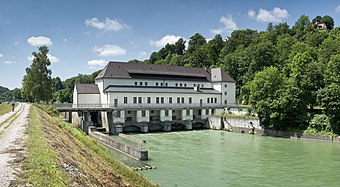Portal:Renewable energy
Introduction Renewable energy (or green energy) is energy from renewable natural resources that are replenished on a human timescale. Using renewable energy technologies helps with climate change mitigation, energy security, and also has some economic benefits. Commonly used renewable energy types include solar energy, wind power, hydropower, bioenergy and geothermal power. Renewable energy installations can be large or small. They are suited for urban as well as rural areas. Renewable energy is often deployed together with further electrification. This has several benefits: electricity can move heat and vehicles efficiently, and is clean at the point of consumption. Variable renewable energy sources are those that have a fluctuating nature, such as wind power and solar power. In contrast, controllable renewable energy sources include dammed hydroelectricity, bioenergy, or geothermal power. Renewable energy systems are rapidly becoming more efficient and cheaper. As a result, their share of global energy consumption is increasing. A large majority of worldwide newly installed electricity capacity is now renewable. In most countries, photovoltaic solar or onshore wind are the cheapest new-build electricity. Renewable energy can help reduce energy poverty in rural and remote areas of developing countries, where lack of energy access is often hindering economic development. Renewable energy resources exist all over the world. This is in contrast to fossil fuels resources which are concentrated in a limited number of countries. There are also other renewable energy technologies that are still under development, for example enhanced geothermal systems, concentrated solar power, cellulosic ethanol, and marine energy. From 2011 to 2021, renewable energy grew from 20% to 28% of global electricity supply. Use of fossil energy shrank from 68% to 62%, and nuclear from 12% to 10%. The share of hydropower decreased from 16% to 15% while power from sun and wind increased from 2% to 10%. Biomass and geothermal energy grew from 2% to 3%. In 2022, renewables accounted for 30% of global electricity generation, up from 21% in 1985. Many countries around the world already have renewable energy contributing more than 20% of their total energy supply. Some countries generate over half their electricity from renewables. A few countries generate all their electricity from renewable energy. National renewable energy markets are projected to continue to grow strongly in the 2020s and beyond. The deployment of renewable energy is being hindered by massive fossil fuel subsidies. In 2022 the International Energy Agency (IEA) requested all countries to reduce their policy, regulatory, permitting and financing obstacles for renewables. This would increase the chances of the world reaching net zero carbon emissions by 2050. According to the IEA, to achieve net zero emissions by 2050, 90% of global electricity generation will need to be produced from renewable sources. Whether nuclear power is renewable energy or not is still controversial. There are also debates around geopolitics, the metal and mineral extraction needed for solar panels and batteries, possible installations in conservation areas and the need to recycle solar panels. Although most renewable energy sources are sustainable, some are not. For example, some biomass sources are unsustainable at current rates of exploitation. (Full article...) Selected article - India is the world's 4th largest consumer of electricity and the world's 3rd largest renewable energy producer with 40% of energy capacity installed in the year 2022 (160 GW of 400 GW) coming from renewable sources. Ernst & Young's (EY) 2021 Renewable Energy Country Attractiveness Index (RECAI) ranked India 3rd behind USA and China. In FY2023-24, India is planning to issue 50 GW tenders for wind, solar and hybrid projects. India has committed for a goal of 500 GW renewable energy capacity by 2030. In line with this commitment, India's installed renewable energy capacity has been experiencing a steady upward trend. From 94.4 GW in 2021, the capacity has gone up to 119.1 GW in 2023 as of Q4. In 2016, Paris Agreement's Intended Nationally Determined Contributions targets, India made commitment of producing 50% of its total electricity from non-fossil fuel sources by 2030. In 2018, India's Central Electricity Authority set a target of producing 50% of the total electricity from non-fossil fuels sources by 2030. India has also set a target of producing 175 GW by 2022 and 500 GW by 2030 from renewable energy. As of September 2020, 89.22 GW solar energy is already operational, projects of 48.21 GW are at various stages of implementation and projects of 25.64 GW capacity are under various stages of bidding. In 2020, 3 of the world's top 5 largest solar parks were in India including world's largest 2255 MW Bhadla Solar Park in Rajasthan and world's second-largest solar park of 2000 MW Pavgada Solar Park Tumkur in Karnataka and 1000 MW Kurnool in Andhra Pradesh. Wind power in India has a strong manufacturing base with 20 manufactures of 53 different wind turbine models of international quality up to 3 MW in size with exports to Europe, United States and other countries. (Full article...)Quotations -
– Ethanol is Here Today Renewable Energy World, 19 August 2010. Main topicsRenewable energy sourcesGeneralRenewable energy commercialization · Smart grid · Timeline of sustainable energy research 2020–present Renewable energy by countryList of countries by electricity production from renewable sources
WikiProjectsWikiProjects connected with renewable energy: Selected image -Selected biography -
Hans-Josef Fell (born 7 January 1952) was a member of the German Parliamentary Group Alliance 90/ the Greens from 1998 to 2013. He served as spokesman on energy for the Alliance 90/The Greens parliamentary group, a member of the Environmental Protection Committee, substitute member of the Committee on Economics and Technology and substitute member of the Defence Committee. Together with Hermann Scheer, he authored the 2000 draft of the Renewable Energy Sources Act, establishing the foundation for the technology developments in photovoltaic, biogas, wind power and geothermal energy in Germany. Fell is founder and president of the Energy Watch Group and an internationally renowned energy and climate change advisor, author and speaker. (Full article...)
Did you know? -... that Selling Solar: The Diffusion of Renewable Energy in Emerging Markets, a 2009 Earthscan book by Damian Miller, argues that in order to solve the climate crisis, the world must immediately and dramatically accelerate the commercialization of renewable energy technology ? This needs to happen in the industrialized world, as well as in the emerging markets of the developing world where most future GHG emissions will occur. General images -The following are images from various renewable energy-related articles on Wikipedia.
Related portalsCategoriesAssociated WikimediaThe following Wikimedia Foundation sister projects provide more on this subject:
Discover Wikipedia using portals |







































![Image 34Concentrated solar panels are getting a power boost. Pacific Northwest National Laboratory (PNNL) will be testing a new concentrated solar power system – one that can help natural gas power plants reduce their fuel usage by up to 20 percent.[needs update] (from Solar energy)](http://upload.wikimedia.org/wikipedia/commons/thumb/8/82/Photo_of_the_Week-_Boosting_Solar_Technology_%288722948189%29.jpg/120px-Photo_of_the_Week-_Boosting_Solar_Technology_%288722948189%29.jpg)










































